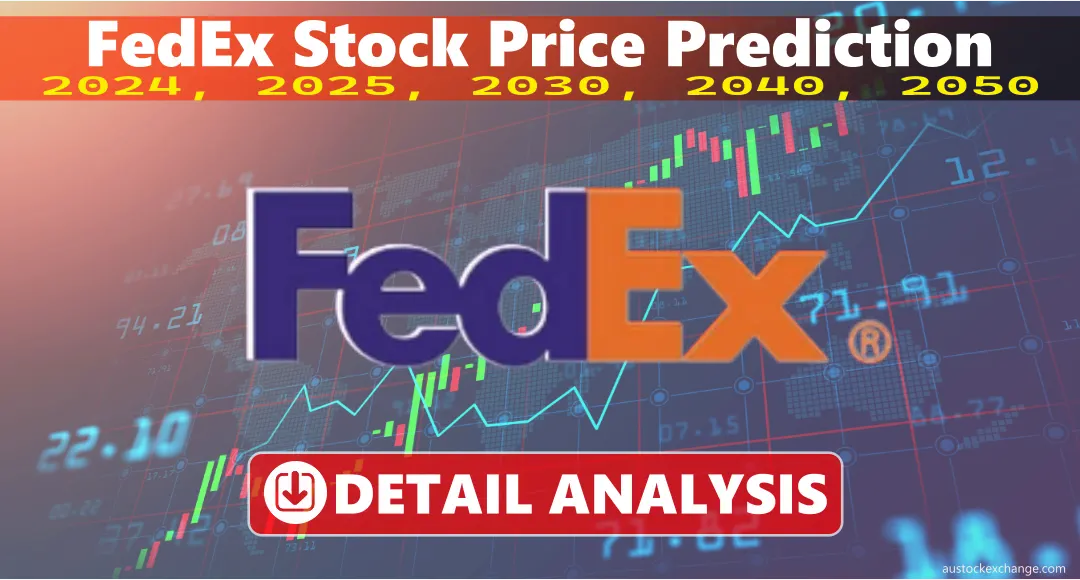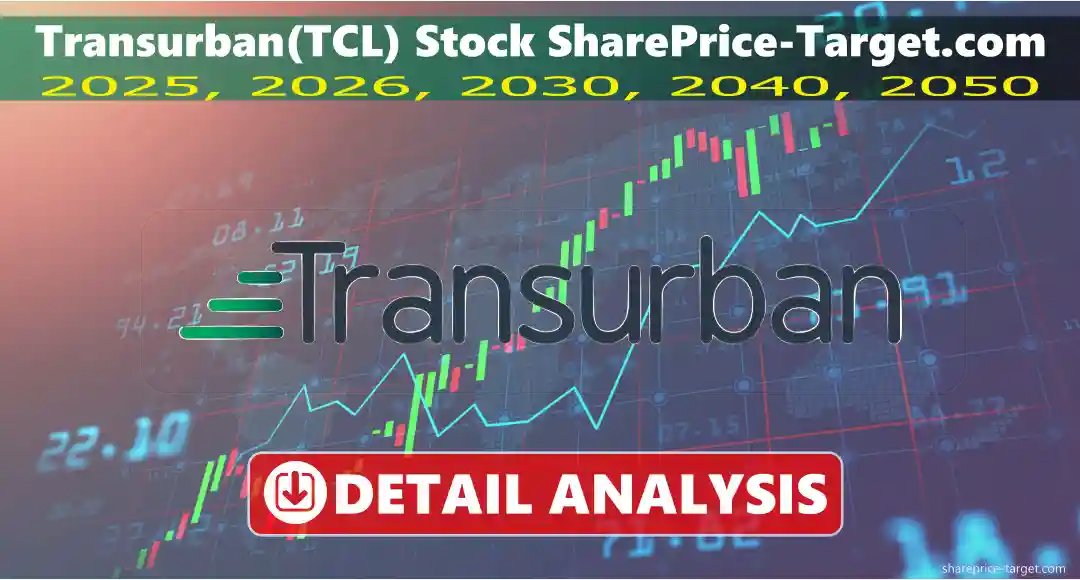FedEx Stock | Stock Price Prediction 2025 – 2050 (Detailed Analysis)
Predicting corporate performance is difficult when investing in the stock market. However, comprehensive study and analysis may help investors make educated investing selections.
This article will examine FedEx Corp (NYSE: FDX), a major logistics and transportation corporation, and its stock price estimates for 2024, 2025, 2030, 2040, and 2050.
What is FedEx Corp NYSE: FDX?
FedEx is a worldwide leader in shipping, e-commerce, and business services. The 1971-founded corporation is now a global iconic brand. FedEx offers rapid delivery, ground transit, and freight services via its extensive air and ground network.
FedEx Stock Price Prediction 2025
In 2025, its stock price would be $287, as per our analysis.
By our prediction, its stock price would be between $178 to $287 in 2025.
| Year | Minimum Price ($) | Maximum Price ($) |
| 2025 | $178 | $287 |
| Month | Minimum Price ($) | Maximum Price ($) |
| January | $263 | $281 |
| February | $244 | $269 |
| March | $217 | $265 |
| April | $184 | $240 |
| May | $178 | $254 |
| June | $188 | $258 |
| July | $209 | $263 |
| August | $215 | $267 |
| September | $220 | $273 |
| October | $227 | $275 |
| November | $241 | $279 |
| December | $250 | $287 |
FedEx Stock Price Prediction 2026
In 2026, its stock price would be $391, as per our analysis.
According to our prediction, its stock price would be between $250 and $391 in 2026.
| Year | Minimum Price ($) | Maximum Price ($) |
| 2026 | $250 | $391 |
Stock Price Prediction 2027
In 2027, its stock price would be $496, as per our analysis.
According to our prediction, its stock price would be between $381 and $496 in 2027.
| Year | Minimum Price ($) | Maximum Price ($) |
| 2027 | $381 | $496 |
Stock Price Prediction 2028
In 2028, its stock price would be $615, as per our analysis.
According to our prediction, its stock price would be between $486 and $615 in 2028.
| Year | Minimum Price ($) | Maximum Price ($) |
| 2028 | $486 | $615 |
Stock Price Prediction 2029
In 2029, its stock price would be $745, as per our analysis.
By our prediction, its stock price would be between $604 and $745 in 2029.
| Year | Minimum Price ($) | Maximum Price ($) |
| 2029 | $604 | $745 |
FedEx Stock Price Prediction 2030
In 2030, its stock price would be $889, as per our analysis.
By our prediction, its stock price would be between $733 to $889 in 2030.
| Year | Minimum Price ($) | Maximum Price ($) |
| 2030 | $733 | $889 |
Stock Price Prediction 2040
In 2040, its stock price would be $2018, as per our analysis.
By our prediction, its stock price would be between $1861 to $2018 in 2040.
| Year | Minimum Price ($) | Maximum Price ($) |
| 2040 | $1861 | $2018 |
Stock Price Prediction 2050
In 2050, its stock price would be $3306, as per our analysis.
By our prediction, its stock price would be between $3100 and $3306 in 2050.
| Year | Minimum Price ($) | Maximum Price ($) |
| 2050 | $3100 | $3306 |
Price Summary
| Year | Minimum Price ($) | Maximum Price ($) |
| 2025 | $178 | $287 |
| 2026 | $250 | $391 |
| 2027 | $381 | $496 |
| 2028 | $486 | $615 |
| 2029 | $604 | $745 |
| 2030 | $733 | $889 |
| 2050 | $3100 | $3306 |
| 2050 | $3100 | $3306 |
Is FedEx Stock Good to Buy? (Bull Case & Bear Case)
Bull Case:
- E-commerce and the need for rapid and dependable delivery services augur well for FedEx’s development.
- FedEx is ready to capitalise on global commerce and logistics possibilities with a strong worldwide footprint.
- Cost-cutting and operational improvements may boost long-term profitability for the organisation.
- Income-seeking investors like FedEx because of its strong brand and frequent dividend payouts.
Bear Case:
- FedEx competes with UPS, Amazon, and other logistics companies, which might hurt its market share and profitability.
- Labour relations issues have disrupted and raised expenses for the corporation, which might hurt operations.
- Fuel price fluctuations may lower FedEx’s operational expenses and profit margins.
- A recession or slowdown in economic development might reduce consumer spending and transportation volumes, hurting FedEx’s revenue and profitability.
Key Details About FedEx
- Headquarters: Memphis, Tennessee, United States
- Founded: 1971
- CEO: Raj Subramaniam
- Employees: Approximately 547,000 (as of 2022)
- Revenue: $94.0 billion (FY 2022)
- Net Income: $3.8 billion (FY 2022)
- Market Capitalization: Approximately $57 billion (as of April 2024)
FedEx Financial (Balance Sheet)
- Total Assets: $80.3 billion (FY 2022)
- Total Liabilities: $54.8 billion (FY 2022)
- Total Equity: $25.5 billion (FY 2022)
- Cash and Cash Equivalents: $6.9 billion (FY 2022)
- Long-Term Debt: $21.5 billion (FY 2022)
Key Performance Indicators
- Revenue Growth (YoY): 8.1% (FY 2022)
- Net Income Growth (YoY): 15.2% (FY 2022)
- Operating Margin: 7.6% (FY 2022)
- Return on Equity (ROE): 15.1% (FY 2022)
- Earnings per Share (EPS): $14.92 (FY 2022)
Comparison with Listed Peers
To comprehend FedEx’s standing in the industry, compare its performance to other significant logistics and transportation firms. Key measures compared to FedEx’s listed peers:
| Company | Market Cap | Revenue | Net Income | Operating Margin | ROE |
| FedEx | $57 billion | $94.0B | $3.8B | 7.6% | 15.1% |
| UPS | $122 billion | $97.3B | $11.5B | 13.3% | 105.8% |
| XPO Logistics | $8.9 billion | $13.2B | $369M | 3.2% | 10.8% |
| C.H. Robinson | $13.6 billion | $23.1B | $917M | 4.7% | 43.4% |
Positive & Negative Factors to Invest in FedEx

Positive Factors:
- FedEx’s dependable and quick delivery services may help attract and keep consumers.
- FedEx Express, FedEx Ground, FedEx Freight, and FedEx Services provide diverse income sources and reduce dependence on any one business unit.
- FedEx has made smart acquisitions like ShopRunner, which may boost its e-commerce skills and consumer base.
- To boost productivity and customer satisfaction, the organisation has invested in automation and data analytics.
Negative Factors:
- FedEx may experience pressure to lower its carbon footprint and embrace more sustainable practices due to environmental criticism of the transportation sector.
- FedEx works in a highly regulated business, therefore trade policy changes might affect its profitability.
- Global transportation business FedEx is vulnerable to cybersecurity attacks, and any breach or data leak might harm its brand and cost it heavily.
- FedEx has struggled with labour relations, and further strikes might hurt company operations and finances.
Conclusion
FedEx Corporation’s stock is appealing to long-term growth and dividend investors. The firm has difficulties and dangers, but its high brand awareness, varied income sources, and strategic objectives position it for development. Before investing, investors should weigh the bull and bear arguments, the company’s financial performance, and industry trends. FedEx stock investment includes balancing risks and benefits.








